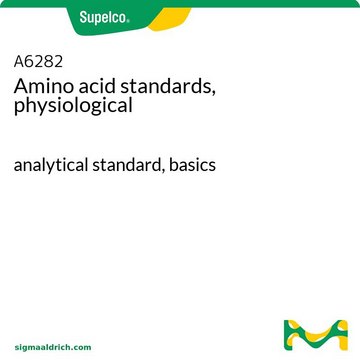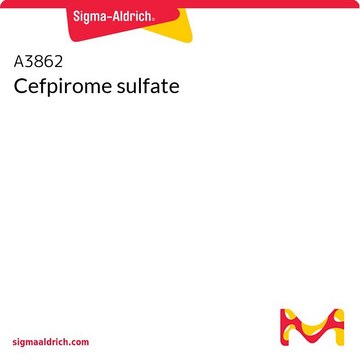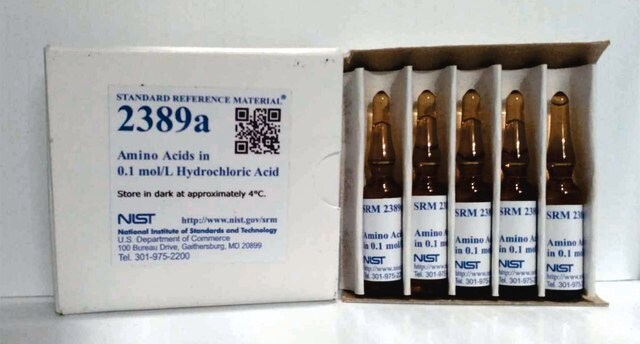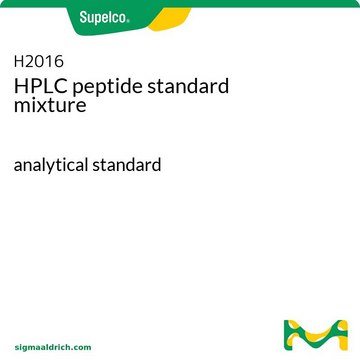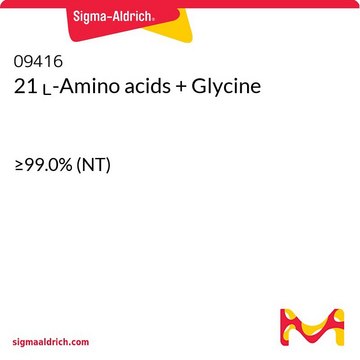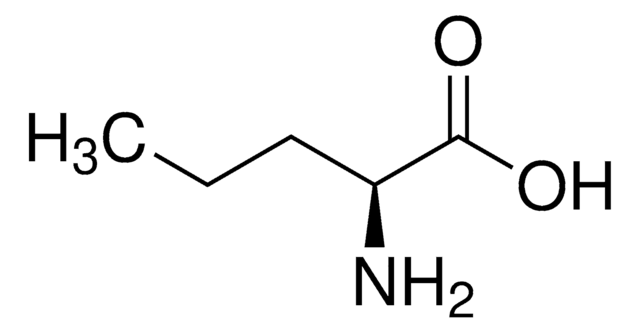A6407
Amino acid standards, physiological
analytical standard, acidics and neutrals
Zaloguj sięWyświetlanie cen organizacyjnych i kontraktowych
About This Item
Polecane produkty
klasa czystości
analytical standard
klasy chemiczne analitów
amino acids, peptides, proteins
metody
HPLC: suitable
gas chromatography (GC): suitable
kolor
colorless
Zastosowanie
food and beverages
format
neat
temp. przechowywania
2-8°C
Szukasz podobnych produktów? Odwiedź Przewodnik dotyczący porównywania produktów
Zastosowanie
This analytical standard was used as follows:
- Identification and quantification of amino acids in the proteins extracted from two cricket species— A. domesticus and G. bimaculatus, using an amino acid analyzer based on ion-exchange chromatography with Ninhydrin for post-column derivatization
- Free amino acid analysis of plasma samples using an amino acid analyzer to evaluate the effect of induced changes in testosterone levels on protein turnover for a group of 30 healthy human males
- Plasma analysis for amino acids using ultra high-performance liquid chromatography coupled to a single quadrupole mass detector (QDA)
- Determination of 26 clinically essential amino acids in plasma samples by liquid chromatography-tandem mass spectrometry (LC-MS/MS) following amino acid amine derivatization
- To spike samples in the liquid chromatography-mass spectrometry (LC-MS) method-based determination of 39 amino acids and related compounds in plasma and urine samples using a mixed-mode (MM) column
Inne uwagi
Amino acids listed are 2.5 μmoles per mL except L-cystine at 1.25 μmoles per ml.
Refer to the product′s Certificate of Analysis for more information on a suitable instrument technique. Contact Technical Service for further support.
This page may contain text that has been machine translated.
Hasło ostrzegawcze
Warning
Zwroty wskazujące rodzaj zagrożenia
Zwroty wskazujące środki ostrożności
Klasyfikacja zagrożeń
Met. Corr. 1
Kod klasy składowania
8B - Non-combustible corrosive hazardous materials
Klasa zagrożenia wodnego (WGK)
WGK 2
Temperatura zapłonu (°F)
Not applicable
Temperatura zapłonu (°C)
Not applicable
Wybierz jedną z najnowszych wersji:
Masz już ten produkt?
Dokumenty związane z niedawno zakupionymi produktami zostały zamieszczone w Bibliotece dokumentów.
Klienci oglądali również te produkty
Amber M Milan et al.
Frontiers in nutrition, 7, 553674-553674 (2020-11-27)
Background: Intolerances to bovine dairy are a motivating factor in consumers seeking alternate-or replacement-dairy beverages and foods. Sheep milk (SM) is an alternate dairy source, with greater protein, although similar amino acid composition compared to cow milk (CM). Studies are
A S Davison et al.
Molecular genetics and metabolism, 125(1-2), 135-143 (2018-07-28)
Concerns exist over hypertyrosinaemia that is observed following treatment with nitisinone. It has been suggested that tyrosine may compete with tryptophan for uptake into the central nervous system, and or inhibit tryptophan hydroxylase activity reducing serotonin production. At the National
M Esperanza Valdés et al.
Food chemistry, 292, 24-31 (2019-05-06)
Must nitrogen is very important for successful fermentation. Irrigation can influence vine nitrogen availability, and therefore must nitrogen content and wine quality. The aim of this work was to assess the effect of vine water status on the nitrogen concentration
Yun Zhou et al.
Neurochemistry international, 123, 101-113 (2018-03-14)
The excitatory amino acid transporter type 2 (EAAT2) represents the major mechanism for removal of extracellular glutamate. In the hippocampus, there is some EAAT2 in axon-terminals, whereas most of the protein is found in astroglia. The functional importance of the
Stefan Jenkins et al.
Frontiers in microbiology, 8, 2618-2618 (2018-01-10)
Exometabolomics enables analysis of metabolite utilization of low molecular weight organic substances by soil bacteria. Environmentally-based defined media are needed to examine ecologically relevant patterns of substrate utilization. Here, we describe an approach for the construction of defined media using
Nasz zespół naukowców ma doświadczenie we wszystkich obszarach badań, w tym w naukach przyrodniczych, materiałoznawstwie, syntezie chemicznej, chromatografii, analityce i wielu innych dziedzinach.
Skontaktuj się z zespołem ds. pomocy technicznej
